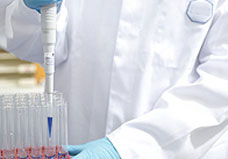| |
 |
|
|
|
|
|
|
Haemoptysis |
|
|
How does a physician manage a
patient who is coughing up blood?
Hemoptysis is a symptom that
involves coughing up blood. This signifies pathology within the
airways and lung tissue that collectively form the respiratory
system. The differential diagnosis, or list of potential causes,
for hemoptysis is extensive, including conditions that are benign
as well as malignant. A physician who evaluates a case of
hemoptysis must consider all of the possibilities.
Causes
Many causes of hemoptysis can be categorized by
anatomic location within the respiratory tract. They are
summarized as follows:
-
Lung Airways: The airways of
the respiratory tract, including the trachea, large bronchi, and
small bronchioles, can bleed when benign or malignant tumors
grow and break the airway epithelial lining. Additionally, acute
or chronic bronchitis can cause bleeding, particularly for the
bronchioles. Other causes of hemoptysis from within the lung
airways include, but are not limited to, trauma, damaged
bronchioles that become dilated (bronchiectasis), and
bronchogenic cysts.
-
Lung Parenchyma: Often,
hemoptysis that originates from the non-airway lung tissue
involves an infection. This can be pneumonia, an infection
encased in fibrous tissue (abscess), tuberculosis, a ball of
fungus (aspergilloma), or other pathogen. Other causes of
bleeding from the lung parenchyma include, but are not limited
to, trauma, tumors, and autoimmune conditions such as
Goodpasture's syndrome.
Besides these pulmonary
etiologies, hemoptysis can also be due to non-pulmonary causes
that eventually involve the respiratory tract. For example, a
variety of cardiovascular conditions can lead to blood leakage
into the lungs, including mitral valve stenosis, aortic
dissection, and left ventricular failure. A variety of bleeding
disorders can also lead to hemoptysis.
Evaluation
When evaluating a patient with hemoptysis, a physician
may ask for further details about the symptom. This is because
bleeding from within the nasal and oral cavities may produce
blood-tinged sputum that can mistakenly be assumed to come from
the lungs. The evaluation may also involve a physical examination
and a chest x-ray. In cases where the diagnosis still remains
uncertain, computed tomography (CT) of the chest can provide
further information.
Treatment
The first step in the treatment of hemoptysis is to
stop any active bleeding and prevent asphyxiation from blood in
the lungs. This can be done with methods such as cauterization and
localized injection of epinephrine. Once that is accomplished,
then other necessary measures are performed to address the
underlying cause, such as surgery for tumors in the respiratory
tract.
|
|
|
|
Haemoptysis - treatment of Haemoptysis,
Haemoptysis types, Disease medicines, Haemoptysis symptoms, Haemoptysis and
Disease symptoms, Haemoptysis symptoms Disease and diagnosis, Symptoms and
Solutions, Signs and Symptoms, type of Haemoptysis, cause common, common
Haemoptysis, Haemoptysis List, causes list, Infectious Haemoptysis, Causes,
Diseases , Types, Prevention, Treatment and Facts, Haemoptysis information,
Haemoptysis: Definition, Haemoptysis names, medical Haemoptysis, medical
Haemoptysis and disorders, cell Haemoptysis, Haemoptysis Worldwide,
Haemoptysis Research, Haemoptysis Control, Haemoptysis Center, Digestive
Haemoptysis Week, Information about Haemoptysis, causes of different
Haemoptysis, Haemoptysis Articles, Haemoptysis and conditions, Health and
Haemoptysis, Haemoptysis Patients, Haemoptysis and Sciences, causes of
alzheimer's Haemoptysis, Haemoptysis causes, alternative medicine heart
Haemoptysis, body ailments, Haemoptysis medicines, medical antiques, type of
blood Haemoptysis
|
|
|





